
Posted on 06/29/2014 4:50:08 AM PDT by Homer_J_Simpson

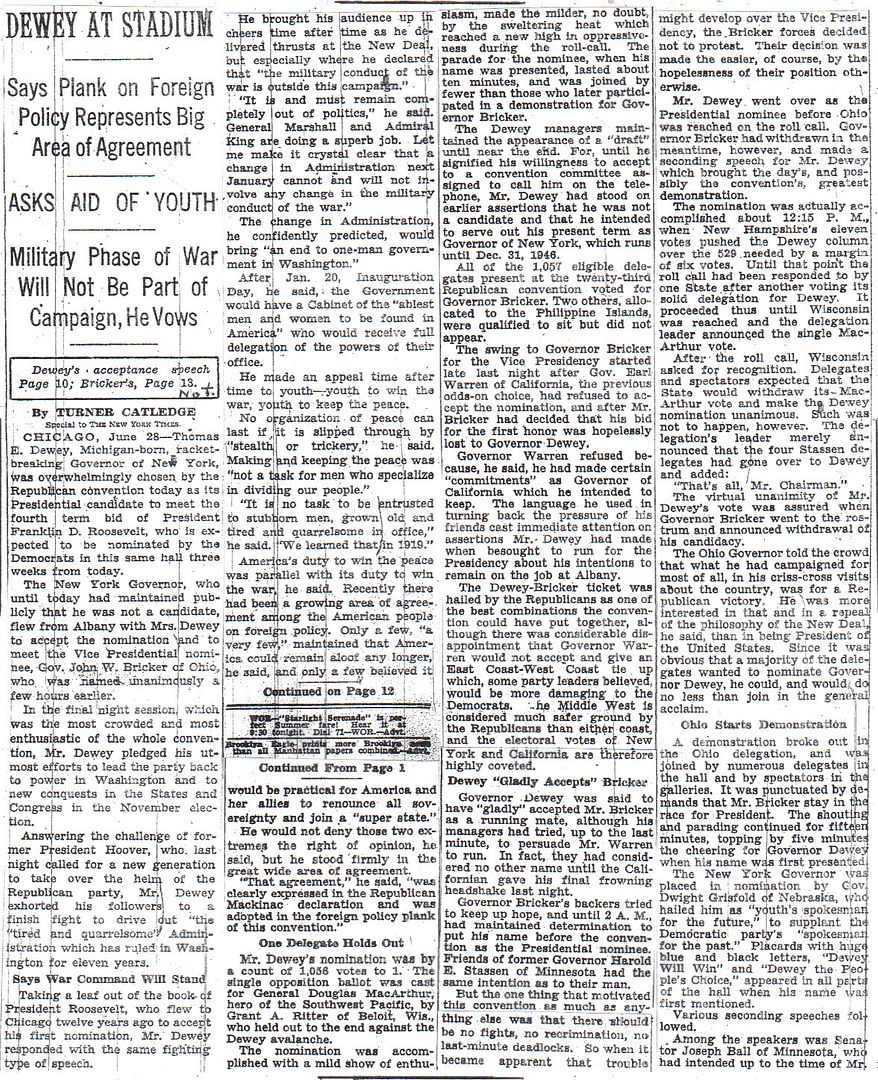
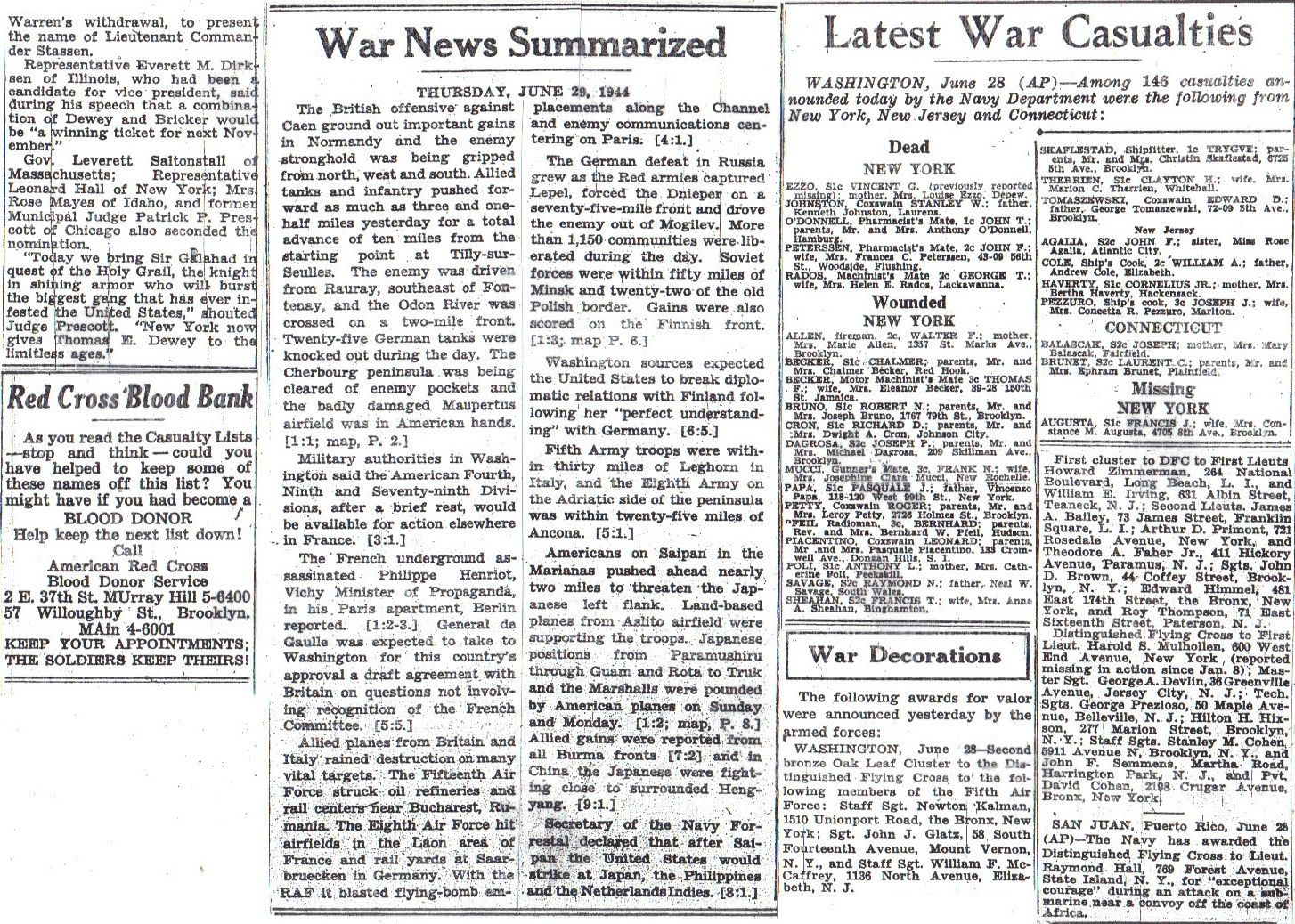
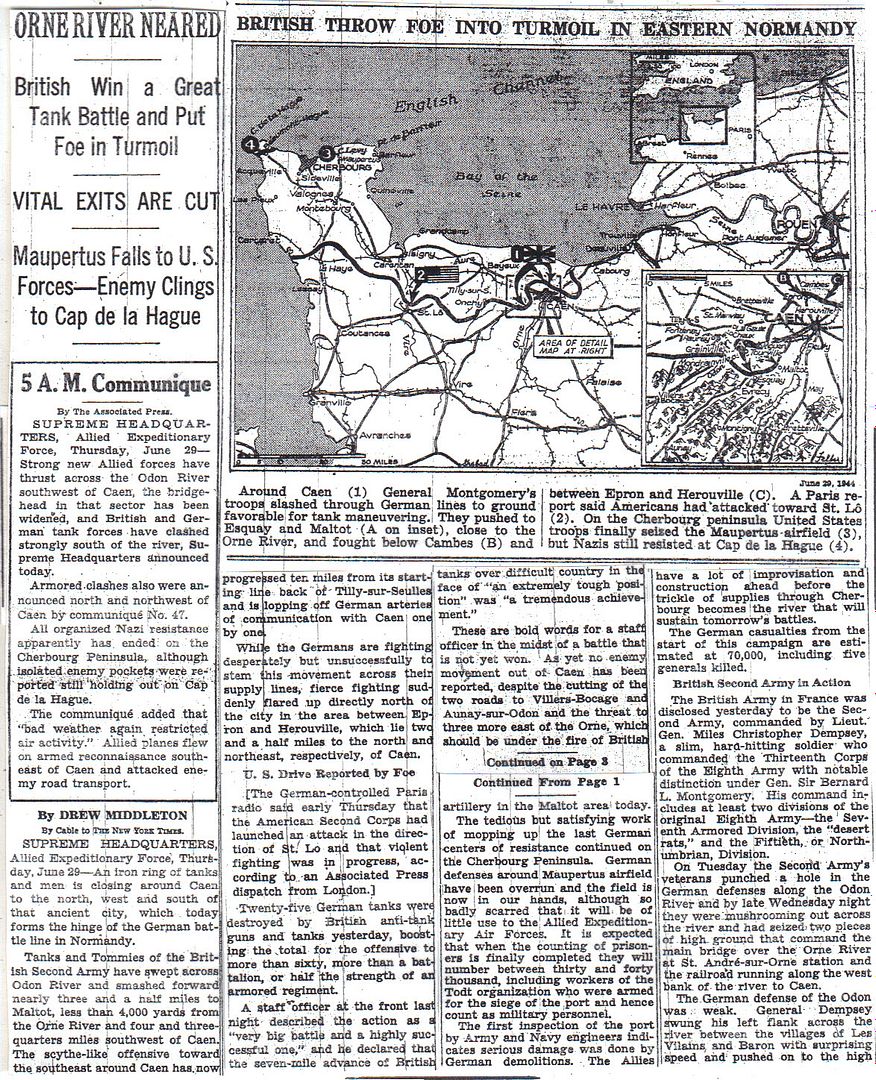
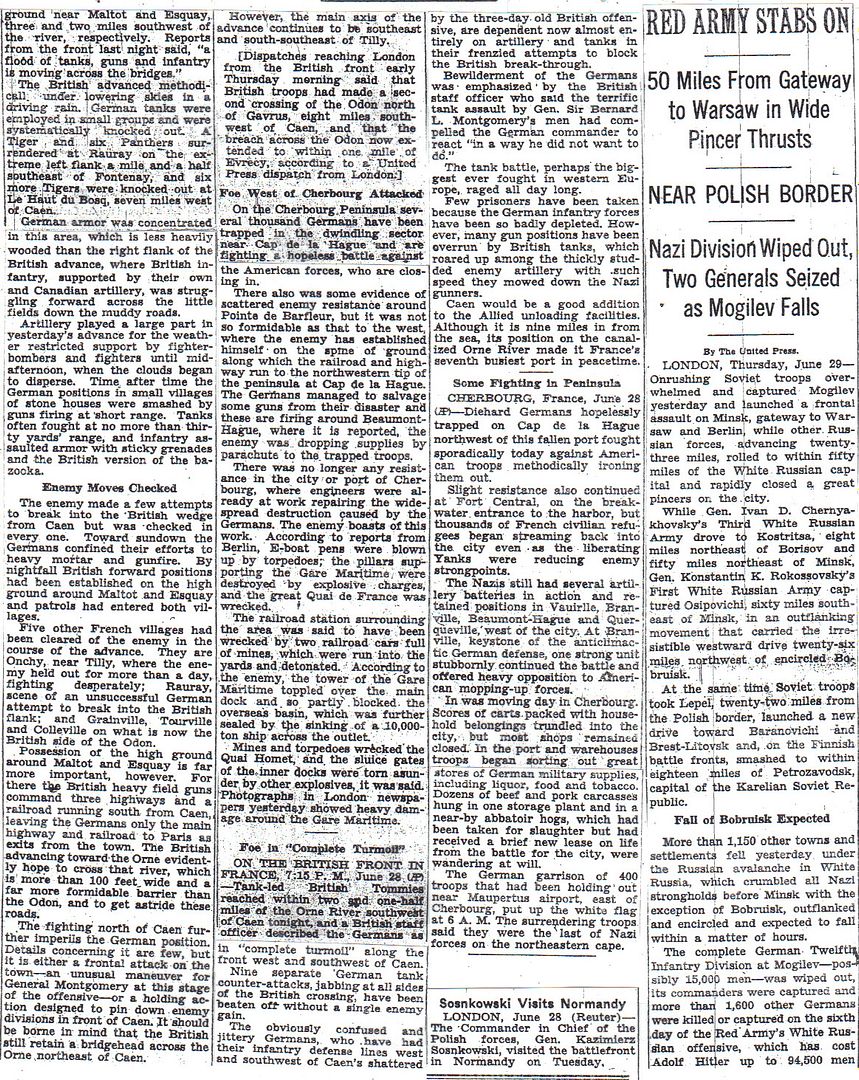
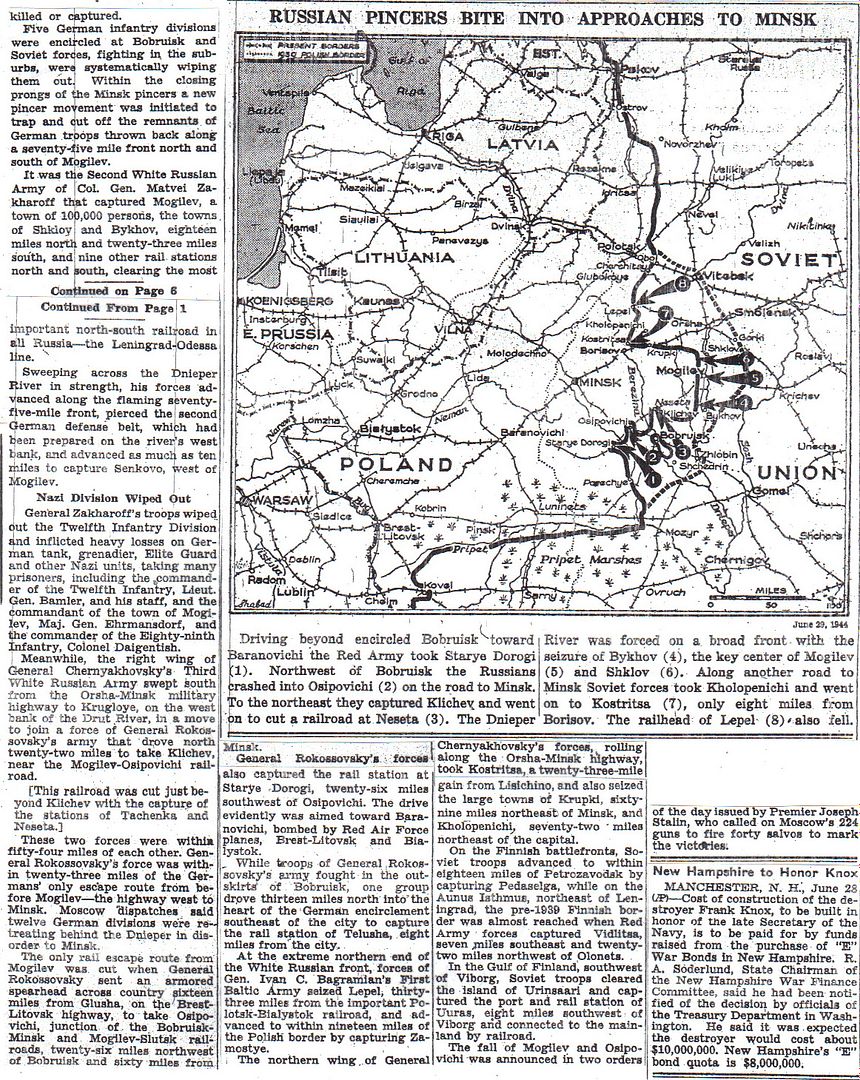

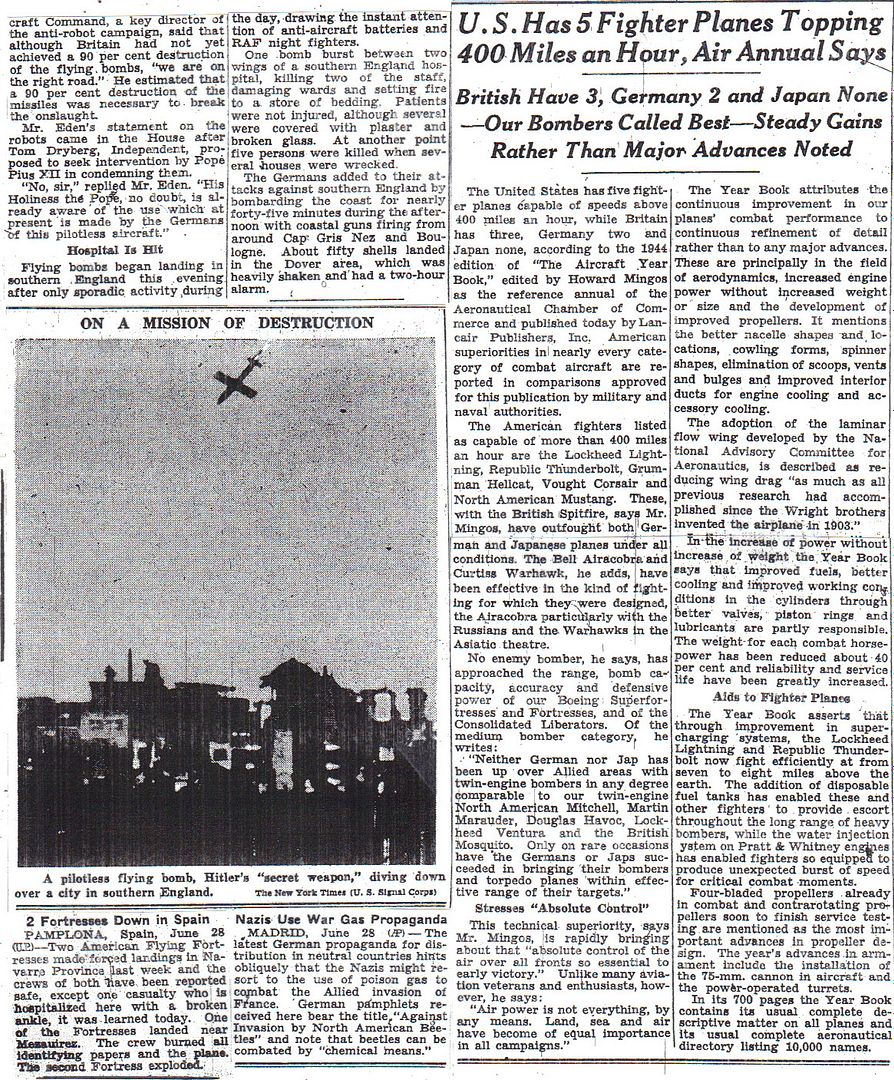
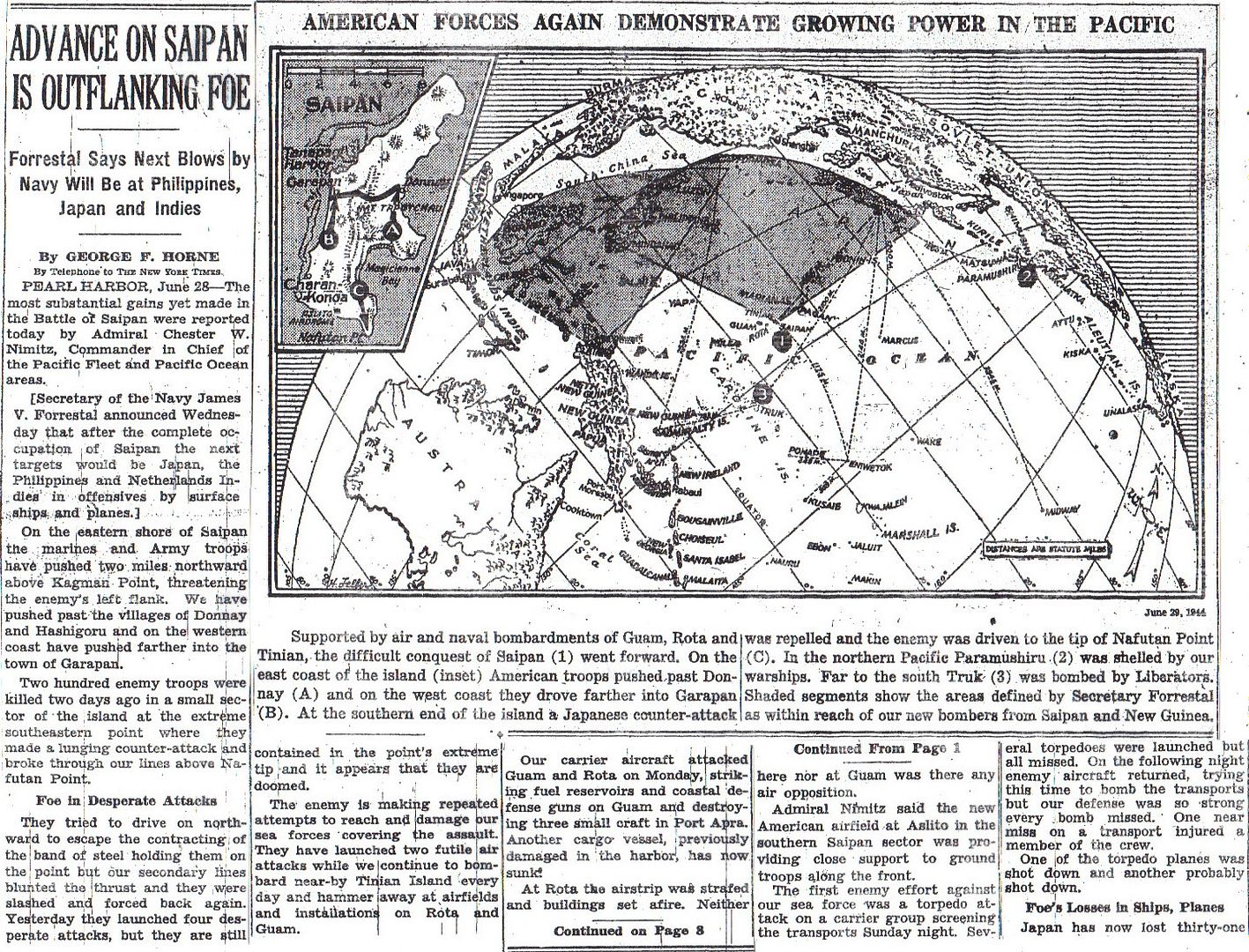
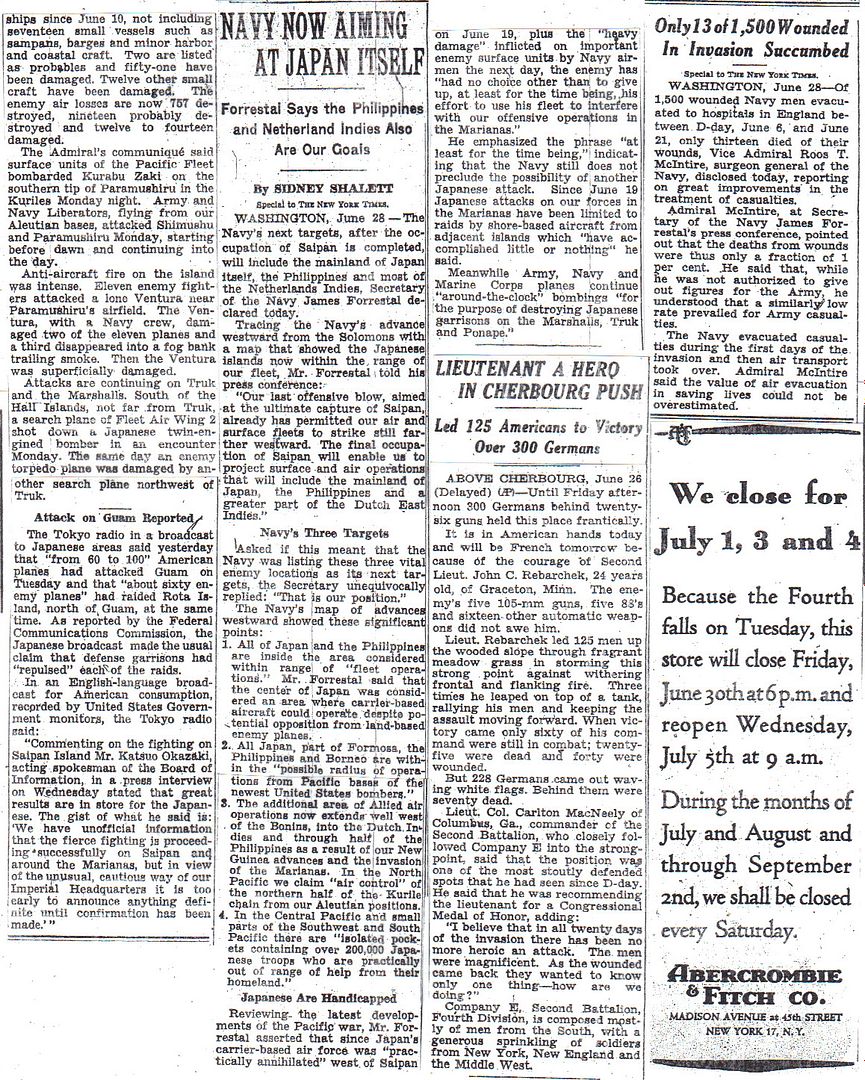

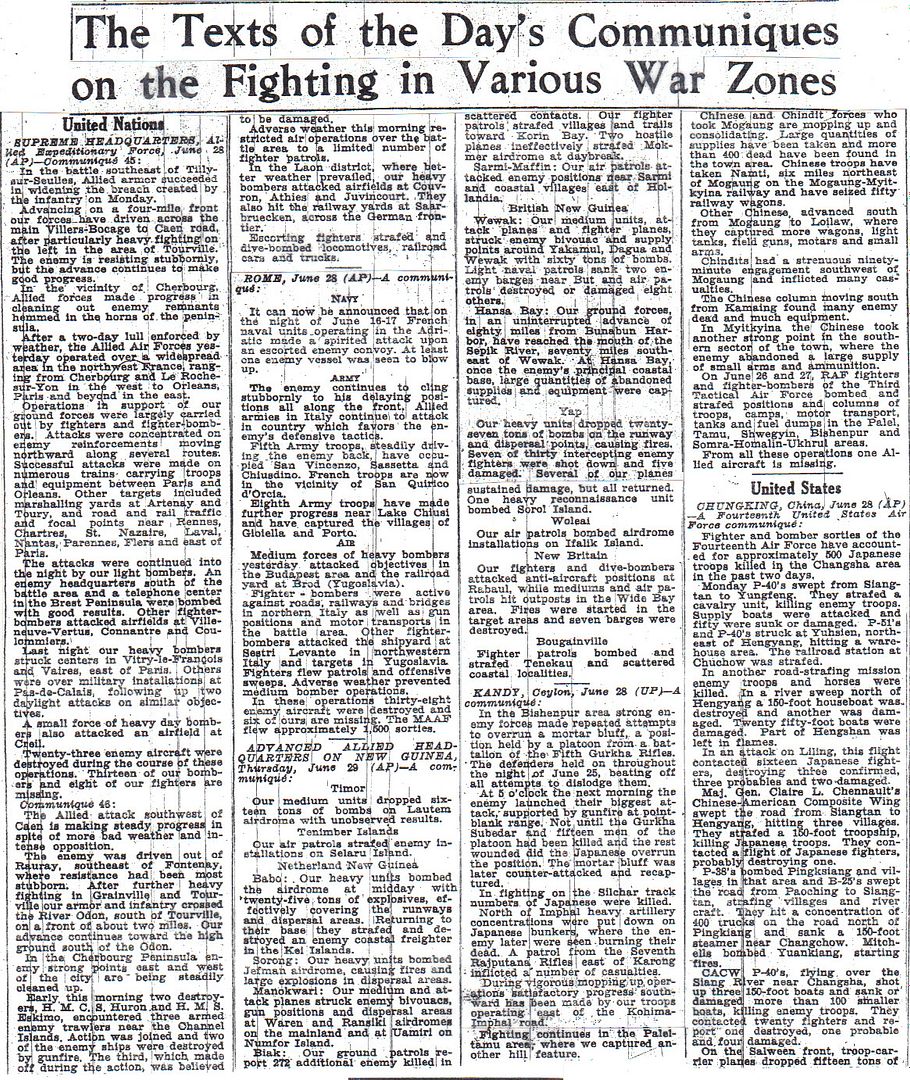

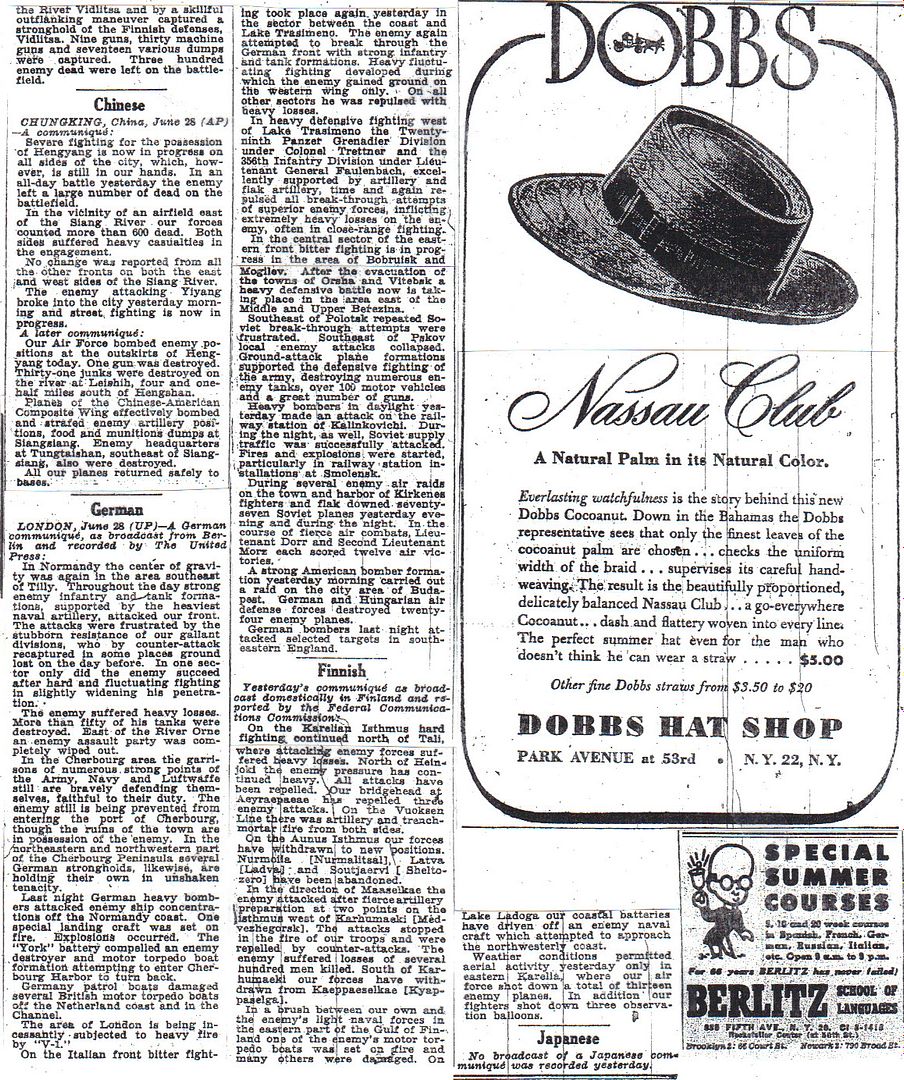
http://www.onwar.com/chrono/1944/jun44/29jun44.htm#
Soviets capture Bobruisk
Thursday, June 29, 1944 www.onwar.com
On the Eastern Front... Initial objectives of the Soviet summer offensive are reached. The 1st Belorussian Front captures Bobruisk. The forces under Rokossovsky have destroyed over 350 armored vehicles, 2600 artillery pieces, killed 50,000 troops and captured 20,000 Germans in less than a week. The forces of 1st Belorussian now aim northwest toward Minsk with the aim of encircling German 4th Army, and the remnants of 9th Army, with forces of the 3rd Belorussian Front advancing southwest, while 2nd Belorussian pins down the German forces east of Minsk.
In New Guinea... Australian forces advancing from Wewak reach the Sepik River, 70 mile to the west. On Biak, American forces mop up lingering Japanese resistance.
http://www.etherit.co.uk/month/thismonth/29.htm
June 29th, 1944 (THURSDAY)
UNITED KINGDOM: US Eighth Air Force flies Mission 447: 1,150 bombers and 779 fighters are dispatched to hit targets in Germany and the Netherlands; 15 bombers and three fighters are lost; cloud cover causes 400+ aircraft to abort the mission:
1. Of 179 B-17s, 81 bomb the synthetic oil plant at Bohlen and 61 strike an aircraft components factory at Wittenberg; four B-17s are lost and 111 damaged.
2. Of 380 B-17s, 41 hit Heiterblick Airfield and 30 hit Taucha Airfield, both at Leipzig; 19 hit Leipzig; 18 hit Wittenberg; 15 hit Limbach;14 hit Quackenbruck; and two hit targets of opportunity; two B-17s are lost, one is damaged beyond repair and 76 damaged.
3. Of 591 B-24s, 81 hit Magdeburg, 74 hit Oschersleben, 54 hit Bernburg, 47 hit Aschersleben, 46 hit Burg Airfield, 42 hit an aviation plant and the Volkswagen factory at Fallersleben, 35 hit targets of opportunity, 26 hit Stendal Airfield, 9 hit Gardelegen Airfield, 8 hit Oebisfelde/Kaltendorf, 8 hit Zerbst Airfield, and 4 hit Leopoldshall marshalling yard; nine B-24s are lost, three damaged beyond repair and 204 damaged.
The missions above are escorted by 203 P-38s, 216 P-47 and 352 P-51s of the Eighth and Ninth Air Forces; they claim 34-0-9 Luftwaffe aircraft in the air and 16-0-8 on the ground; three P-51s are lost.
Four P-38s fly a fighter-bomber mission against shipping at Ijmuiden, the Netherlands without loss.
ENGLISH CHANNEL: U-988 (Type VIIC) which the previous day had sunk HMS Pink, is itself sunk in the English Channel west of Guernsey, at position 49.37N, 03.41W, by depth charges from the British destroyers HMS Essington, Duckworth, Domett and Cooke. 50 dead (all crew lost). (On 8 Sept, 1943 this boat had a collision with its sister ship U-983 in the Baltic Sea training waters, and U-983 sank with loss of 5 men.) (Alex Gordon)
At 1528, U-984 fired a spread of two LUT torpedoes at Convoy EMC-17 about 30 miles south of St Catherine’s point on the Isle of Wight. The first struck the Edward M. House and the second the H.G. Blasdel. Six minutes later, U-984 fired a single torpedo at one of the damaged ships and missed but struck the John A. Treutlen. At 1543, a Gnat was fired which struck the James A. Farrell. Edward M. House was struck by one torpedo under the stern as she was proceeding as the third or fourth ship in the port column. The explosion threw up a column of water several hundred feet in the air, stove in the forepeak, flooded the #1 port and starboard deep tanks and buckled the shell plating and the collision bulkhead. The engines were stopped briefly during the damage was examined and then followed the convoy. One armed guard and one crewman were injured of the nine officers, 33 men, 28 armed guards (the ship was armed with two 3in and eight 20mm guns) and 587 troops on board. The ship continued to the Normandy beachhead, discharged her troops and equipment the same day and returned to the United Kingdom on 1 July. She was repaired at Newcastle-upon-Tyne from 9 July to 31 October and then sailed for New York, returning to service. H.G. Blasdel in station #12 was struck by the torpedo on the port side at the #5 hold. The explosion extensively damaged the interior of the ship. The entire stern section sagged, leaving the after gun platform laying partially submerged. The hold and shaft alley immediately flooded and the engine room filled with water until the top of the cylinders lay submerged. Gasoline in the vehicles in #5 hold caught fire and firefighting parties from the crew extinguished it. The ship was anchored to keep her from drifting into a minefield and to await tugs. None of the eight officers, 36 crewmen and 28 armed guards (the ship was armed with two 3in and eight 20mm guns) were lost, but 76 of the 436 soldiers on board died and 180 others were injured. At 1615 the wounded were transferred to a British corvette, which came alongside and 15 minutes later a British buoy tender arrived to help with the injured. At 1700 HMS LST-326 arrived alongside to take off the remaining troops and only a skeleton crew remained on board. Six hours later as the stern threatened to break off; an American tug made fast to the vessel and towed her to Southampton, where the ship was beached bow first. The vessel broke in two and was declared a total loss. The wreck was scrapped in 1947. James A. Farrell was right behind the John A. Treutlen in the port column and had to take a 40° turn to avoid a collision. Moments later a torpedo struck on the starboard side just forward of the stern post. The explosion threw water mast high, tore a large hole in the hull, blew off the propeller and twisted the bent the rudder, blew off the #5 hatch cover and buckled the main deck. The shaft alley, steering engine room, #3, #4 and #5 holds flooded and the engines were secured as the ship slowly settled by the stern. Four soldiers died in the #5 hold and 45 were injured when the hatch cover and beams collapsed. The eight officers, 34 crewmen, 31 armed guards (the ship was armed with one 5in, one 3in and eight 20mm guns) and surviving 417 soldiers all went directly on board the British landing ship HMS LST-50, which came alongside to port after one hour. All survivors were landed at Portland the same evening. A British tug towed the reboarded vessel to Spithead, arriving on 30 June. On 1 July, she was moved to shallow water near Netley Beach, where the cargo was removed until 8 July. On 13 July, the vessel was beached there, declared a total loss and later scrapped in place. John A. Treutlen was struck by one torpedo on the port side between the #5 hold and the after peak tank and blew a large hole in the side. The explosion lifted the stern out of the water and flames and water shot into the air. It forced its way forwards and set off the after magazine. This second explosion blew another huge hole in the port side. The blast broke the shaft, destroyed the steering gear and cracked the vessel athwartships, leaving the stern hanging several feet lower. The most of the eight officers, 35 crewmen and 31 armed guards (the ship was armed with one 5in, one 3in and eight 20mm guns) abandoned ship in three lifeboats, leaving only a skeleton crew of twelve men and the master on board. The survivors, ten of them injured (nine armed guards and one crewman) were picked up by HMCS Buctouche and USS LST-336 and taken to Southampton on 30 June. The next morning, the tug WSA-2 arrived and towed the vessel to Southampton, where she was beached. The cargo was salved and the vessel declared a total loss. The John A. Treutlen was on her maiden voyage and had loaded cargo at Savannah and Jacksonville, Florida. She proceeded to New York and left on 5 May, en route to the Clyde in Convoy HX-290 arriving in Scotland on 19 May
About 1600, the Empire Portia in Convoy FMT-22 was badly damaged by an explosion off Selsey Bill. The vessel was taken in tow by HMS LST-416, but the tow parted and she grounded with a broken back on Peel Bank near Ryde, Isle of Wight. The forward section was towed to Falmouth, the aft section to Briton Ferry, South Wales and subsequently broken up. The master and 41 crewmembers were saved, but five crewmembers were lost. U-988 did not return from patrol, so it is not clear whether this ship was torpedoed or mined.
FRANCE: British 21st Army Group reports a total of 22,460 casualties since D-Day. There are 7,335 infantry replacements available. (Jay Stone)
Almost 200 B-26 Marauders and A-20 Havocs of the USAAF’s Ninth Air Force bomb gun batteries on Cap de la Hague, bridges and rail lines in the Rennes-Saint-Hilaire-du-Harcourt-Vitre areas, and rail bridge at Oissel; fighters fly armed reconnaissance and attack enemy aircraft, road and rail traffic, gun positions, bridges and other targets in wide areas throughout northwestern France.
GERMANY: Berchtesgaden: Von Rundstedt, Rommel, Sperrle and Kroncke attend a special “Fuhrer conference” at which Hitler does not allow them to tell him the true situation on the western front; instead he promises more V-weapons and jet fighters.
U-2503 is launched.
EASTERN FRONT: Rokossovsky’s forces take Bobruysk, Slutsk and Lyuban. They also cross the Berezina.
Bobruisk, the last German bastion at the southern end of the smashed “Fatherland Line” in Byelorussia, has been stormed by the Red Army. The road is now clear for a pincer movement to enfold the Byelorussian capital of Minsk.
Latest reports say that the Russians have already taken the railway junction of Osipovichi, only 60 miles south-east of Minsk. These latest successes, following the crossing of the Dnieper on a 75-mile front and the wiping out of the German garrison of Vitebsk, are celebrated in an order of the day addressed to Gen Konstantin Rokossovky. Arrested before the war on Stalin’s orders, Rokossovsky is C-in-C of the First Byelorussian Front and planned this campaign. Operation Bagration. He has been rewarded today by promotion to marshal.
In an attempt to stop his advance Hitler has ordered that key towns such as Vitebsk, Mogilev and Polotsk be held as Feste Platze [firm positions] and defended to the last man and the last round. The result, as in Vitebsk, has been the sacrifice of units bypassed and then destroyed by the Russians.
German General der Artillerie Martinek XXXIX Pz.Kps is killed at Beresinow. (138)(Russ Folsom)
FINLAND: Finnish troops leave Äänislinna (Petroskoi), the largest town occupied by Finns in Eastern Karelia.
Battle of Tali-Ihantala
This morning Commander of the Isthmus Troops Lt. Gen. Karl Oesch, after consulting commander of the IV Corps Lt. Gen. Taavetti Laatikainen, orders the IV Corps to straighten its line by withdrawing its right flank to a new line at the level of Ihantala. Maj. Gen. Ruben Lagus’s Armored Division shall be withdrawn from battle to form the Isthmus Troops reserve, and Maj. Gen. Kaarlo Heiskanen’s 11th Division will be transferred to Maj. Gen. Antero Svensson’s V Corps as soon as Maj. Gen. Einar Wihma’s 6th Division can replace it. This evening IV Corps front is also narrowed by transferring Col. L. Haanterä’s 3rd Brigade on its right flank to the V Corps.
Since the Soviet forces broke free from the salient east of Lake Leitimonjärvi, Col. Albert Puroma’s Jäger Brigade, Col. Martti Aho’s IR 50 and Lt. Col. E. Polón’s IR 30 have been in danger of being isolated. Now their task is to disengage from battle and withdraw to the new line. However, the Soviet forces press on, and Finns have to conduct a fighting withdrawal.
After midnight the enemy tanks reach the Portinhoikka crossroads, but once again Maj. Heikki Mikkola pushes them back with a prompt counter-attack. Soviets stage another attempt at 7 am, but are slowed down by fierce resistance by the I and II battalions of the IR 50 supported by StuG IIIg’s of the Armored Division. Finally the enemy is stopped a kilometer short of the crossroads. But IR 50’s position is becoming endangered as the enemy forces are reaching its rear. The orders to withdraw to a new line reaches the IR 50 at noon. All through the afternoon and evening the two battalions slowly withdraw under heavy artillery fire, fighting back and slowing the enemy advance. Col. Aho is wounded, and replaced by Maj. I. Kaila. At one point III/IR 50 has to fight its way out from encirclement, but by evening both battalions have reached the new line. The Portinhoikka crossroads has to left to the enemy.
North of Lake Leitimonjärvi the Jäger Brigade, I/IR 50 and IR 30 (minus one battalion) still man the positions they had reached after the attempts to cut the Soviet salient yesterday. They also receive the order to withdraw around noon, but not all the units receive it on time. There are serious problems with communicating the orders to the battalions. Finally some units have to fight their way out from encircelement, carrying their dead and wounded.
The newly arrived 6th Division continues this morning its offensive from Ihantala south along the Portinhoikka-Ihantala -road. It’s able to conquer some ground, but is stopped by enemy artillery and air forces. At 12.30 pm. Col. Y. Hanste’s IR 12 tries again. It’s supported by artillery, air forces and German StuG’s of the Sturmgeschütz-Brigade 303. The aim is to reach the point where a road branches north-west towards Vakkila. By 2 pm. Hanste’s regiment has advanced near its goal, but taken heavy losses from the enemy artillery. It’s forced to withdraw. The regiment repels several attacks by enemy tanks, destroying a number with the newly arrived German at-weapons, Panzerfausts and -schrecks.
East of the Soviet salient Col. Sven Björkman’s forces are subjected to a furious Soviet assault early in the morning. The Border Jäger Battalion 2 repels several attacks, even after the III/IR 48 on its right flank retreats at 10am. It valiently fights on alone for ten hours, holding the enemy and destroying several tanks. But the border jägers can’t hold on alone for ever, and are forced to withdraw at 8 pm.
This results in a dangerous gap in the Finnish defences east of Lake Ihantalanjärvi (which lies east of the village of Ihantala, which is just about to become the focus of the battle). As soon as he is informed of this danger, Gen. Wihma sends his reserves to plug the gap, and the neighbouring Maj. Gen. Aleksanteri Autti’s 4th Division also reacts by sending troops (this fighting took place just west of the boundary between the 6th and 4th divisions). By midnight the situation is just under control.
Today is the most critical day in the Battle of Tali-Ihantala. The IV Corps is able to shorten its line under heavy pressure, but this feat succeeds just barely, and many units has to fight their way out from encirclement. But another critical phase has just begun: after the 6th Division has arrived, no more reinforcement are coming. (As these postings are concentrated at the Battle of Tali-Ihantala, it has to be pointed out that the Red Army was pressing on all along the Isthmus and elsewhere the Fenno-Soviet front. This manner they prevented Finns from transferring more divisions to Ihantala, and probed for weak spots that could possibly be exploited.) This has to be enough to stop the Soviet offensive. The line around Ihantala has to be held.
Helsinki: A pro-German clique, headed by President Rysto Ryti, is planning to fight on against the Russians, in defiance of the wishes of the people and the majority of the democratic parliament. Six members of the government have resigned in protest, and Ryti is replacing them with men who will not oppose him despite the increasing hopelessness of Finland’s military position. The latest blow to the Finns is a warning delivered by the US secretary of state, Cordell Hull, that America is considering breaking off diplomatic relations.
NEW GUINEA: Australian forces have advanced west from Wewak 70 miles to the Sepik River.
MARIANAS ISLANDS: The Japanese continue aerial attacks on Saipan and the ships supporting the American operations. At least four aircraft are shot down by US Navy F6F Hellcat pilots and a USAAF P-61 Black Widow pilot.
ALEUTIAN ISLANDS: In the Aleutian Islands, two Eleventh Air Force B-25s fly a negative shipping sweep.
U.S.A.: CINCPAC COMMUNIQUÉ NO. 66, Organized resistance at Nafutan Point on Saipan Island ceased on June 27 (West Longitude Date). The entire point has been occupied by our forces. Small gains were made along the western shore into Garapan Town, and in the center of the island.
Our advance northward is being made against severe enemy resistance.
On the night of June 27 enemy aircraft dropped bombs in the area occupied by our forces. Two of the attacking planes were shot down by antiaircraft batteries.
Carrier aircraft attacked Pagan Island on June 27. Barracks and a water reservoir were hit. Only one plane was seen on the ground, and it appeared unserviceable. Several small craft badly damaged in previous strikes were hit by rocket fire.
Truk Atoll was bombed by Seventh Army Air Force Liberators on June 27, and neutralization raids were made against objectives in the Marshall and Caroline Islands on June 26 and 27.
JUNE 29, 1944 NAVAL AVIATORS HAVE DESTROYED MORE THAN 6,259 JAPANESE AIRPLANES
Naval Aviators have shot 5,521 Japanese warplanes out of the air since Pearl Harbor, while losing 1,260 planes in aerial combat. At least 65 per cent of the U. S. Navy airmen shot down have been rescued.
In addition to the 5,521 Jap aircraft destroyed in the air, Naval Aviators have, in 1944 alone, destroyed at least 738 Jap planes on the ground. Only 17 Navy planes were lost in this way during the same period.
This 43 to 1 ratio in ground destruction partially explains the drop in ratio of U. S. air victories In the last three months from 4.7 to 1 to 4.4 to 1, according to Rear Admiral A. W. Radford, USN, Acting Deputy Chief of Naval Operations (Air). He explained that the accumulation of Naval strength in the Pacific, plus increasing effectiveness of Navy aerial recon-naissance, has made it possible for carrier task forces to surprise the Japanese and destroy their aircraft before they can become airborne to fight.
“As a result,” Admiral Radford said, “fewer Jap planes are available for us to shoot down. In addition, the Jap pilot is becoming less and less anxious to close with our pilots. So the air ratio of victories has dropped slightly. This is more than compensated, however, by the 43 to 1 ground ratio. We don’t care where they are when we destroy them”
Compilation of statistics in ground destruction of planes for 1942 and 1943 is being completed, but that phase of the aerial war during that period was relatively unimportant.
Combining the available figures not including ground losses of 1942 and 1943, the Navy enjoys a 4.8 to 1 advantage over Japan in the air war, having shot out of the air and destroyed on the ground a total of 6,259 planes, as against 1,277 planes lost. These figures for destruction of Jap planes do not include losses inflicted by antiaircraft fire. They cover the period from December 7, 1941, through June 23, 1944. The figures for the period May 1 through June 23, 1944, are not final.
One reason for the increased air losses of Navy planes in 1944 over 1942 and 1943 is the loss of planes in the incessant Bombing raids on Jap holdings, such as the Kuriles, Truk and the Marshalls, where aerial opposition is rarely encountered any more, but where heavy antiaircraft exacts a toll-a very small toll in relation to the frequency and intensity of the bombing raids carried out.
The record of air losses by years follows:
Year Japs Navy Ratio
1942 (including December 1941) 1134 384 3-1
1943 2212 351 6.3-1
1944 2175 525 4-1
Total 5521 1260 4.4-1
1944 (ground) 738 17 43-1
Grand total 6259 1277 4.8-1
All of the Navy’s planes have played a part in amassing the victory record. Naturally, it was the fighters-Grumman Hellcat and Wildcat and Vought Corsair-which scored the large majority of the victories, either while escort-ing the torpedo and dive bombers, or while defending American sea and land forces. The bombers-Grumman Avenger, Douglas Dauntless and Curtiss Helldiver, Consolidated Catalinas and Liberators, Lockheed Venturas-drove home the heavy blows while the fighters fended off the enemy’s air forces.
The Wildcat and Avenger are also built by General Motors’ Eastern Aircraft Division, the Corsair by Goodyear. The Helldiver is also built by Canadian Car and Fairchild of Canada, the Liberator by Ford and Douglas.
CINCPAC PRESS RELEASE NO. 464, Aslito Airfield on Saipan Island today was renamed Isely Field in honor of Commander Robert Henry Isely, USN, Commander of Torpedo Squadron Sixteen, who was shot down June 12 by Japanese antiaircraft fire as he was leading a bombing attack on the field.
The change in name was recommended by Vice Admiral Marc A. Mitscher, Commander, Fast Carrier Task Force, Pacific Fleet, and was made by Admiral Chester W. Nimitz, Commander in Chief, U. S. Pacific Fleet and Pacific Ocean Areas. Aslito Airdrome was first attacked by carrier aircraft of Admiral Mitscher’s task force in February of this year.
A Naval aviator since 1937, Commander Isely had taken part in attacks at Tarawa and other Gilbert Islands, at Kwajalein, Palau, Woleai and Truk. He flew aerial cover for General MacArthur”> MacArthur’s troops when they landed in Hollandia in New Guinea. Admiral Mitscher’s recommendation was based on Commander Isely’s gallant performance of duty during all of these Pacific actions. ‘ (Denis Peck)
Submarine USS Greenfish laid down.
Aircraft carrier USS Randolph launched.
Destroyer escort USS Damon M Cummings commissioned.
Minesweeper USS Design commissioned.
CANADA: Corvette HMCS Orillia arrived Bermuda for workups.
Corvette HMCS Sackville assigned to close escort for 116 ship Convoy HX 297 (New York City to Liverpool). The convoy arrives safely in Liverpool on 11 July 1944.
Frigate HMCS LaSalle commissioned.
Corvette HMCS Petrolia commissioned.
Corvette HMCS Tillsonburg commissioned.
PO CEG Noble RCNR and Skr Joseph Eudore Napoleon Vezina RCNR awarded Long Service and Good Conduct Medal.
Senator Bricker was later the author of the “Bricker amendment” (which was never enacted) prohibiting international treaties and agreements that would restrict American Constitutional rights: http://www.fee.org/the_freeman/detail/globalism-and-sovereignty-a-short-history-of-the-bricker-amendment
I see the Times is preparing the readers for Dewey’s landslide victory over that low-rent hick Truman.
I wish Sen. John Bricker (R-Ohio) were at the top of the ticket. He's a lot more conservative than Dewey and would have a better chance at beating FDR.
I wonder if the RNC’s excitement over the successful D-Day landings was tempered by the knowledge that their national convention was scheduled for 3 weeks later. I wonder how history would be different if Ike had been forced to release his prepared message accepting full responsibility for the failure of the landings. Would we have gotten a President Dewey in ‘44?
Or would M'Arthur have reemerged as a "no, I'm really not a candidate, but ..."?
Wrong election. Dewey loses to FDR in 1944 before losing to Truman in 1948.
Oh, I know ... but you don’t set up something like Dewey’s landslide victory overnight.
Possibly, but the simple fact is Overlord could not have failed. It was too big, too well planned and had such overwhelming force and logistics support that the Germans could not possibly stop it.
The worst that could have happened was failure on Omaha Beach. Which would have been made up by using the other beaches.
Dewey is a poor candidate running against very popular incumbent who is benefiting from a well run war.
“MARIANAS ISLANDS: The Japanese continue aerial attacks on Saipan and the ships supporting the American operations. At least four aircraft are shot down by US Navy F6F Hellcat pilots and a USAAF P-61 Black Widow pilot.”
I may have posted this before but I was surprised to see how far along the development of the “Black Widow’ night fighter was BEFORE the US even entered the war!
http://en.wikipedia.org/wiki/P-61_Black_Widow
In August 1940, 16 months before the United States entered the war, the U.S. Air Officer in London, Lieutenant General Delos C. Emmons, was briefed on British research in RADAR (Radio Detection and Ranging), which had been underway since 1936 and had played an important role in the nation’s defense against the Luftwaffe during the Battle of Britain. General Emmons was informed of the new Airborne Intercept radar (AI for short), a self-contained unit that could be installed in an aircraft and allow it to operate independently of ground stations. In September 1940, the Tizard Mission traded British research on many aspects including radar for American production.
Northrop Specification 8A was formally submitted to Army Air Material Command at Wright Field, on 5 December 1940.
Someone correct me if I am wrong, but I have not been able to find any refernce to a World War 2 era ship named the President Tyler or just the Tyler. The DD-468 Taylor (a Fletcher-class destroyer of the United States Navy, named for Rear Admiral William Rogers Taylor) was operating in the Solomon Islands during this time peroid.
I'm having trouble finding solid info on that ship myself. Here is a little something.
7.5 hours every night only permits a few hours to move before having to stop, cover tracks and get everything camouflaged before sunrise.
Disclaimer: Opinions posted on Free Republic are those of the individual posters and do not necessarily represent the opinion of Free Republic or its management. All materials posted herein are protected by copyright law and the exemption for fair use of copyrighted works.